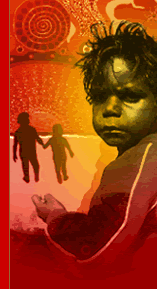

|
|
||
Media ReleasesSNAICC Briefing paper - Indigenous Families socio-economic dataDemographics 22 per cent of the whole population is under 15 years of age, 40 per cent of the Indigenous population is under 15. 7 per cent of the whole population is under 5 years of age, 15 per cent of the Indigenous population is under 5 years 68 % of the total Indigenous population are under the age of 30 Child and Family Welfare According to the AIHW1998/9 report on child protection, Indigenous children are still upto six times more likely to be removed from their families than other children. The key causal factors AIHW note in the report include:
Child placement in foster care Despite the acceptance of the Indigenous Child Placement Principle approx 25% of Indigenous children removed from their families are still placed with non Aboriginal foster parents. Life expectancy at birth Life expectancy at birth among non Indigenous people was 74.9 years for males and 80.6 years for females, life expectancy at birth was 15 to 20 years lower for Indigenous people Education Between 1995 and 1999 access to pre school education for Indigenous children declined - for all other children it increased. This was due to the increasing Indigenous population, age structure of the Indigenous population and a failure to provided enough new pre school places. Young Aboriginal and Torres Strait Islander people were more likely to leave school early - one third had left school by age 15 or younger, compared to 15% for all young people. Unemployment rates Unemployment persists at much higher rates amongst Aboriginal and Torres Strait Islander people than the whole Australian community. The unemployment rate is highest for Indigenous people 15 to 19 year olds, 50%, and also very high for 20 to 24 year olds, 46%. Nature of employment 26% of Indigenous people in employment were employed in the Community Development Employment Project, CDEP scheme, which is a work for the dole scheme provided through ATSIC. Participation in the CDEP scheme grew rapidly from about 4,000 in 1991 and 25,000 1995. Increases in the employment of Indigenous people between 1991 and 1994 were largely the result of this growth in CDEP. Annual Household income 20% of Indigenous households had an annual household income of less than $16,000 per annum. A further 40% had household incomes of between $16,001 and $40,000. Homelessness Despite their small proportion of the total population Aboriginal and Torres Strait Islander people make up 14% of all the clients under the Supported Accommodation Assistance Program and Indigenous families are 20 times more likely to be homeless than non Indigenous families. Unaffordable and overcrowded housing In 1995 17% of all Australian households were living in unaffordable or overcrowded housing or both. By comparison 38% of Indigenous households were living in these conditions. Law and Justice According to the Australian Institute of Criminology Indigenous children and young people are 21.3 times more likely to be incarcerated than their non Indigenous counterparts. Major Source: The Health and Welfare of Australia's Aboriginal and Torres Strait Islander Peoples. Australian Institute of Health and Welfare and The Australian Bureau of Statistics.
|
||
